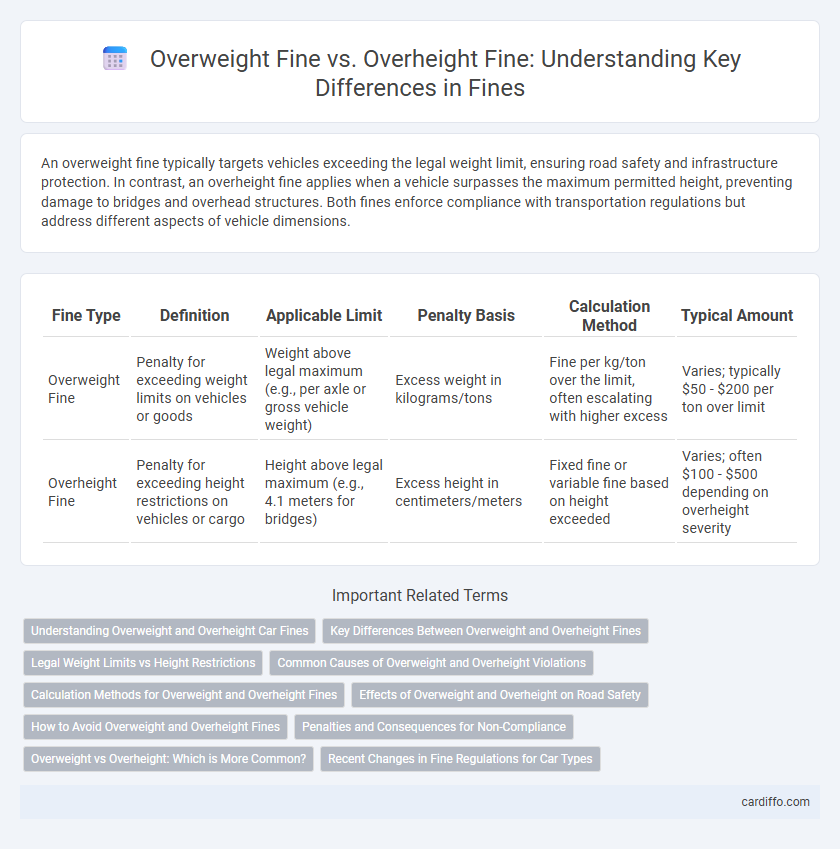An overweight fine typically targets vehicles exceeding the legal weight limit, ensuring road safety and infrastructure protection. In contrast, an overheight fine applies when a vehicle surpasses the maximum permitted height, preventing damage to bridges and overhead structures. Both fines enforce compliance with transportation regulations but address different aspects of vehicle dimensions.
Table of Comparison
| Fine Type | Definition | Applicable Limit | Penalty Basis | Calculation Method | Typical Amount |
|---|---|---|---|---|---|
| Overweight Fine | Penalty for exceeding weight limits on vehicles or goods | Weight above legal maximum (e.g., per axle or gross vehicle weight) | Excess weight in kilograms/tons | Fine per kg/ton over the limit, often escalating with higher excess | Varies; typically $50 - $200 per ton over limit |
| Overheight Fine | Penalty for exceeding height restrictions on vehicles or cargo | Height above legal maximum (e.g., 4.1 meters for bridges) | Excess height in centimeters/meters | Fixed fine or variable fine based on height exceeded | Varies; often $100 - $500 depending on overheight severity |
Understanding Overweight and Overheight Car Fines
Overweight fines are penalties imposed when a vehicle exceeds the legal weight limit, which is critical for preventing road damage and ensuring safety by reducing the risk of accidents due to overloaded vehicles. Overheight fines apply when a vehicle surpasses the maximum allowed height, which helps protect infrastructure like bridges and tunnels from structural damage and ensures smooth traffic flow. Understanding these fines involves recognizing the specific thresholds set by transportation authorities and the potential consequences of non-compliance, including financial penalties and legal liabilities.
Key Differences Between Overweight and Overheight Fines
Overweight fines are issued when a vehicle exceeds the maximum allowable weight limits set by transportation authorities, while overheight fines are imposed when a vehicle surpasses height restrictions that could risk structural damage or safety hazards. The calculation for overweight fines typically depends on the amount of excess weight and distance traveled, whereas overheight fines are usually a fixed penalty based on the violation of vertical clearance regulations. Enforcement of overweight fines involves weigh stations and portable scales, contrasting with overheight fines enforced by clearance sensors and height detection systems at entry points.
Legal Weight Limits vs Height Restrictions
Legal weight limits for vehicles are strictly enforced to prevent road damage and ensure safety, with overweight fines imposed when these limits are exceeded. Height restrictions are established to protect infrastructure such as bridges and tunnels, and overheight fines are applied when vehicles surpass these maximum height allowances. Both overweight and overheight fines serve as regulatory tools to maintain road integrity and public safety, with distinct criteria based on weight and height measurements.
Common Causes of Overweight and Overheight Violations
Overweight and overheight fines commonly arise from miscalculations in cargo weight or improper loading, leading to vehicles exceeding legal limits set by transportation authorities. Frequent causes include inaccurate cargo documentation, failure to distribute weight evenly, and neglecting vehicle manufacturer specifications for height clearance. Understanding and adhering to weight and height regulations is essential to avoid penalties and ensure road safety.
Calculation Methods for Overweight and Overheight Fines
Overweight fines are typically calculated based on the amount by which the vehicle's weight exceeds the legal limit, often determined per ton or percentage over the maximum gross vehicle weight. Overheight fines are computed by measuring the extent to which the vehicle's height surpasses the regulated clearance limit, with penalty rates increasing per centimeter or inch over the allowed height. Both fines use specific regulatory formulas and scales established by transportation authorities to ensure proportional penalties based on the degree of violation.
Effects of Overweight and Overheight on Road Safety
Overweight vehicles significantly increase the risk of road accidents due to compromised braking efficiency and tire blowouts, leading to severe damage and potential fatalities. Overheight vehicles pose dangers by striking bridges, overpasses, and power lines, causing structural damage and traffic disruptions. Both overweight and overheight infractions strain infrastructure integrity and elevate maintenance costs, directly impacting road safety and transportation efficiency.
How to Avoid Overweight and Overheight Fines
To avoid overweight fines, ensure your vehicle complies with weight limits by regularly checking cargo weight and distributing loads evenly before transport. Prevent overheight fines by measuring the vehicle height against posted clearance limits and using GPS systems tailored with bridge height restrictions. Adhering to these precautions reduces the risk of penalties and ensures safer road travel.
Penalties and Consequences for Non-Compliance
Overweight fines impose substantial financial penalties based on the excess weight carried beyond legal limits, with fees escalating per ton over the maximum allowed, potentially reaching thousands of dollars. Overheight fines similarly penalize vehicles exceeding height restrictions, often resulting in immediate stop orders, mandatory route deviations, and hefty charges to prevent infrastructure damage. Failure to comply with either overweight or overheight regulations can lead to increased enforcement actions, including vehicle impoundment, license suspensions, and legal liabilities for damages caused.
Overweight vs Overheight: Which is More Common?
Overweight fines are typically more common than overheight fines due to the higher frequency of cargo weight miscalculations in transportation logistics. Overweight violations often result from inaccurate load assessments or improper weight distribution, whereas overheight infractions generally occur less frequently due to standardized height restrictions and clear signage. Statistical data from transportation safety boards indicate overweight fines constitute the majority of regulatory penalties issued in freight and trucking industries.
Recent Changes in Fine Regulations for Car Types
Recent changes in fine regulations have imposed stricter penalties for overweight vehicles, reflecting increased enforcement of load limits to enhance road safety and reduce infrastructure damage. Overheight fines have also been updated, with revised thresholds and higher fees for vehicles exceeding legal height, aimed at preventing bridge and tunnel collisions. These regulatory adjustments target specific car types such as commercial trucks and heavy-duty vehicles, ensuring compliance through advanced monitoring technologies.
Overweight fine vs overheight fine Infographic

 cardiffo.com
cardiffo.com